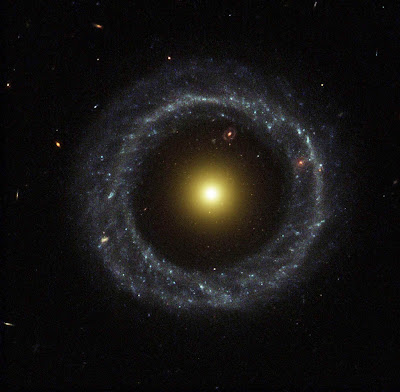On 16
May 2016, an international team of astrophysicists discovered a new optical Einstein ring called
Canarias Einstein Ring. Einstein Ring is a distorted image of a galaxy, the
source, which is very distant from the Earth. The results of the discovery were
published in the international journal Monthly Notices of the Royal
Astronomical Society. The discovery was made by a team comprising of doctoral
student Margherita Bettinelli from the Instituto de Astrofisica de Canarias
(IAC) and the University of La Laguna (ULL) of Spain. The rare phenomenon was
discovered in the Sculptor constellation, IAC J010127-334319, in the vicinity
of the Sculptor Dwarf Spheroidal Galaxy
Saturday, 3 September 2016
New Material Makes N-Fuel Recycling Cleaner, Cheaper
Scientists
have found a new material that may help recycle and reduce wastage of nuclear
fuels as well as save energy, making the reprocessing of radioactive materials
cleaner and less expensive. Conventional technologies to remove these
radioactive gases operate at extremely low, energy-intensive temperatures. By
working at ambient temperature, the new material – known as metal-organic
frameworks – can save energy, make reprocessing cleaner and less expensive. The
reclaimed materials can also be reused commercially.
A New DNA Treatment As The Future Of Cancer Treatment
A revolutionary
new DNA treatment technique makes you six times more likely to beat cancer. The
new technique involves having a simple £200(Rs 19,386) DNA test of your tumour
first. This them tells doctors precisely which drugs or therapies are most
suited to you, rather than relying on the standard treatment.
Precision
medicine studies presented at the American Society of Clinical Oncology annual
meeting are expected to show unprecedented results. One study of 13,000
patients taking part in early clinical trials of drugs found those undergoing
genetic testing of their tumours before any treatment – so that they could then
be given targeted therapies instead of standard drugs were six times more
likely to see their tumours shrink or disappear altogether. It is the first analysis
of precision medicine treatments.
It is a
very different way to treatment. It’s the most exciting thing since
chemotherapy. It was about using reliable technology to better treat patients and
giving them the most appropriate choice. Precision medicine was about finding
the right key for the lock, finding out what it is that is driving the tumour,
what make it tick. At the moment, it is informed guesswork, so that treatment
often doesn’t work for large numbers of patients. I believe the potential of
precision medicine is huge.
Universal Cancer Vaccine Gets a Step Closer
Scientists
have inched closer towards creating a universal vaccine against cancer that
makes the body’s immune system attack tumours as if they were a virus. An international
team of researchers described how they had taken pieces of cancer’s genetic RNA
code, put them into tiny nanoparticles of fat and then injected the mixture
into the blood streams of three patients in the advanced stages of the disease.
The patients’ immune systems responded by producing “killer” T-cells designed
to attack cancer. The vaccine was also found to be effective in fighting “aggressively
growing” tumours in mice.
Such vaccines are fast and
inexpensive to produce, and virtually any tumour antigen (a protein attacked by
the immune system) can be encoded by RNA. Thus, the nonoparticulate RNA immunotherapy
approach introduced here may be regarded as a universally applicable novel
vaccine class for cancer immunotherapy. The aim of trial was not to test how
well the vaccine worked. While the patients’ immune systems seemed to react, there
was no evidence that their cancers went away as a result. In one patient, a
suspected tumour on a lymph node got smaller. Another patient, whose tumours
had been surgically removed, was cancer-free seven months after vaccination. The
third patient had eight tumours that had spread from the initial skin cancer
into lungs. These tumours remained “clinically stable”.
The vaccine, which used different
pieces of RNA, activated dendritic cells that select target for the immune
system to attack, the vaccine also produced limited flu-like side effects in
contrast to the extreme sickness caused by chemotherapy. Cancer immunotherapy
is currently causing significant excitement in the medical community. It is
already being used to treat some cancers with a number of patients still in
remission more than 10 years after treatment. While traditional cancer treatment
for testicular and other form of the disease can lead to a complete cure, lung
cancer, melanoma, and some brain and neck cancers have proved difficult to
treat.
Immunotherapy for cancer is a
rapidly evolving and exciting field. This new study shows that an immune
response against the antigens within a cancer can be triggered by a new type of
cancer vaccine. There is uncertainty around whether the therapeutic benefit
seen in the mice will also apply to humans, and the practical challenge of
manufacturing nanoparticles for widespread clinical application.
Subscribe to:
Comments (Atom)



